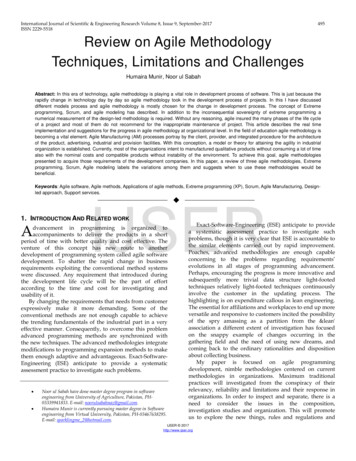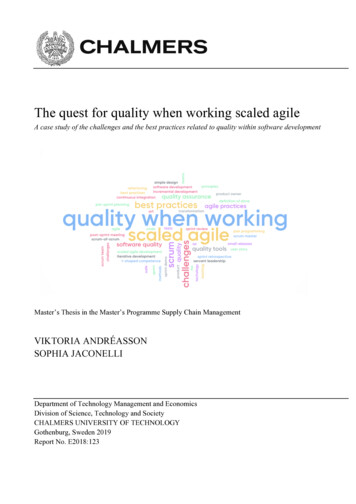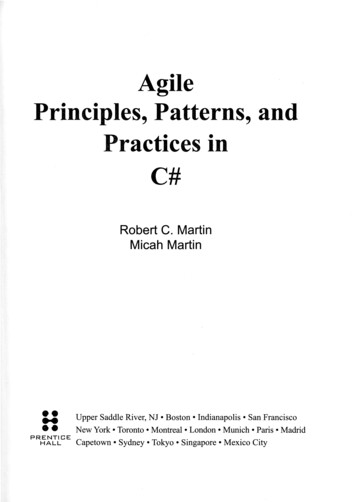
Transcription
10 Best Practices forAgile Software DevelopmentHow to develop high-quality software?Prof. Fabio KonDepartment of Computer ScienceUniversity of São PauloMIT Senseable City LabJanuary, 11th, 20191
What is Software Development?Modeling– Engineering– Discipline– Poetry– Craft– )(Gabriel)(from Alistair Cockburn) Common mistake: look at software as onlyone of the above items.2
Conventional SoftwareDevelopmentWaterfall model (pervasive from 1960s to early 2010)1. Requirement elicitation2. Requirement analysis3. Design4. Implementation5. Tests6. Maintenance3
Old Assumptions one must do the best possible job in one stagebefore starting the next oneit’s very costly to change something in apreviously completed step4
But the world is now different Requirements change very rapidlyThe customer doesn’t know what he/shewantsIt’s easy to change (well written) software–new languages, frameworks, methods, tests5
In the Agile mindset You’re always ready to:–change everything (requirements, code, plans)–interact with your customer –to show what you did and get feedbackto receive new requestsreplan the next steps6
In the Agile mindset You perform all the steps of the waterfalleveryday (or every week):Customer negotiationDesignImplementationTestsMaintenance7
10 Agile Best Practices Intention-revealingnamesDesign Patterns Code Reviews Version Control CustomerInvolvementManagement &PlanningAutomated Tests Development,Homologation(Acceptance), andProductionenvironmentsContinuous DeliveryWhen and how tooptimize8
1. Intention-revealingNames9
Meaningful NamesNames are vital! Code is basically names and reserved words Choosing good names takes time but savesmore than it takes Names should be expressive and shouldanswer questions10
Meaningful NamesExamplepublic List int[] getThem() {List int[] list1 new ArrayList int[] ();for (int[] x : theList)if(x[0] 4)list1.add(x);return list1;}11
Meaningful NamesExamplepublic List int[] getThem() {List int[] list1 new ArrayList int[] ();for (int[] x : theList)if(x[0] 4)list1.add(x);return list1;}Many doubts arise.1. What does this method get?2. What kinds of things are in theList?3. What is the importance of the zeroth position?4. What is the significance of the value 4?12
Meaningful NamesExamplepublic List int[] getThem() {List int[] list1 new ArrayList int[] ();for (int[] x : theList)if(x[0] 4)list1.add(x);return list1;}What about thiscode?public List int[] getFlaggedCells() {List int[] flaggedCells new ArrayList int[] ();for (int[] cell : gameBoard)if(cell[STATUS VALUE] FLAGGED)flaggedCells.add(cell);return flaggedCells;}13
Meaningful NamesExamplepublic List int[] getFlaggedCells() {List int[] flaggedCells new ArrayList int[] ();for (int[] cell : gameBoard)if(cell[STATUS VALUE] FLAGGED)flaggedCells.add(cell);return flaggedCells;}Problemsolved!1. What does this method get? It gets all flagged cells!2. What kinds of things are in theList? theList is a gameBoard filled withcells!3. What is the importance of the zeroth position? That's the Status Value!4. What is the significance of the value 4? It means it is flagged!14
Meaningful NamesExamplepublic List int[] getFlaggedCells() {List int[] flaggedCells new ArrayList int[] ();for (int[] cell : gameBoard)if(cell[STATUS VALUE] FLAGGED)flaggedCells.add(cell);return flaggedCells;}Going further.public List Cell getFlaggedCells() {List Cell flaggedCells new ArrayList Cell ();for (Cell cell : l);This is prettyreturn flaggedCells;much what you}expected!15
Meaningful Namessummarizing seek intention-revealing names good names are neither too short nor too long (do notpromote obscurity to save a couple of keystrokes) if you find a bad name, change it now!16
2. Design Patternson the shoulders of giants Design Patterns: elements of reusableobject-oriented software - GoF book Architectural Patterns (MVC, Pub/Sub, etc.) Implementation Patterns (Beck and Martin)17
Design Patternson the shoulders of giants Design Patterns: elements of reusableobject-oriented software - GoF book Architectural Patterns (MVC, Pub/Sub, etc.) Implementation Patterns (Beck and Martin)18
3. Customer Involvementdon’t be shy:talk to all stakeholders Show preliminary, icremental versions ofyour software to: client user other stakeholders (in academia: colleagues, conferences)Get frequent feedback19
4. Management and Planning An Agile software development team: 2 to 10 members coach (experienced developer) product owner (customer) other developers: testing manager, devops manager, DBmanager, planning manager, etc. (but everybody does everything, themanager simply makes sure it’s being done)20
Management and Planning Agile Planning happens everyday. Layered approach: Long-term planning is very vague, just a vision Medium-term planning is vague Short-term planning (monthly) is more detailed Very-term-planning (weekly) is very detailedStory Cards are written by customer to describerequirements On the Back of story cards, developers list thetasks that are required to implement that card21
Management and Planning Tool Support for Agile Planning: Trello GitLab / GitHub issue tracker JIRA, Pivotal Tracker, etc.Release planning Periodic meeting (with the entire team) to planthe next release Customer defines priorities Developers define development costs22
5. Automated Testsif it’s not tested, it doesn’t exist Each relevant line of code should have anautomated test associated with it. Unit tests Acceptance tests Integration tests Smoke tests Performance tests Stress tests23
Automated Testsif it’s not tested, it doesn’t exist If you are a beginner, I suggest you start withUnit tests Use a framework for your specific language pytest, JUnit, CPPUnit, etc. Web: SeleniumA large project should have thousands ofautomated tests and 90% of testing coverage The testing suite should be executedeveryday (may times per day)24
Automated TestsMAJOR BENEFITS Communication (Self-checking) Documentation Safety net for changes/refactorings Helps one developer undestand the codewritten by the others25
6. Code Reviews Collective code ownership Periodic code peer-review Pair programming26
7. Software Execution environments Development Environment e.g., your notebook should standardize in the teamHomologation (Acceptance) Environment for the customer to try/test/play with should be as similar as possible to productionProduction Enviroment for the real users with real data27
8. Code version control Code must be maintained in a repository, notin your [notebook, dropbox, server file system] The repository should use a modern VersionControl System (VCS) git is a bit tricky but it’s very powerful VCS github, gitlab, are good online repositories28
9. Continuous DeliveryAutomate the entire process:1) Write some new code2) Run automated tests3) if all pass - push to Repository4) Deploy new version in Homologation Environment5) Run Smoke tests6) Deploy new version in Production Environment7) Shut down old version in Production Environmentand redirect users to new versionDevOps29
10. When and how to optimizePremature optimization is the root of all evil inprogramming (or at least most of it)Donald Knuth1) Only optimize if a functional ornon-functional requirement is not met2) Run a profiler and identify where’s the bottleneck3) optimize just that bottleneck and go back to step 1)30
The Endfabiokon@mit.edukon@ime.usp.br31
21 Management and Planning Agile Planning happens everyday. Layered approach: Long-term planning is very vague, just a vision Medium-term planning is vague Short-term planning (monthly) is more detailed Very-term-planning (weekly) is very detailed Story Cards are written by customer to describe requirements On the Back of story cards, developers list the











